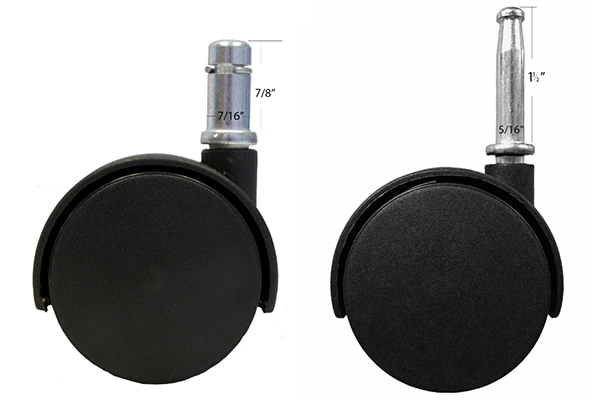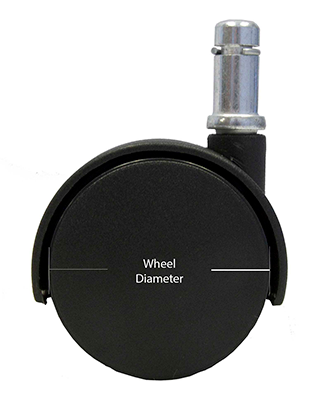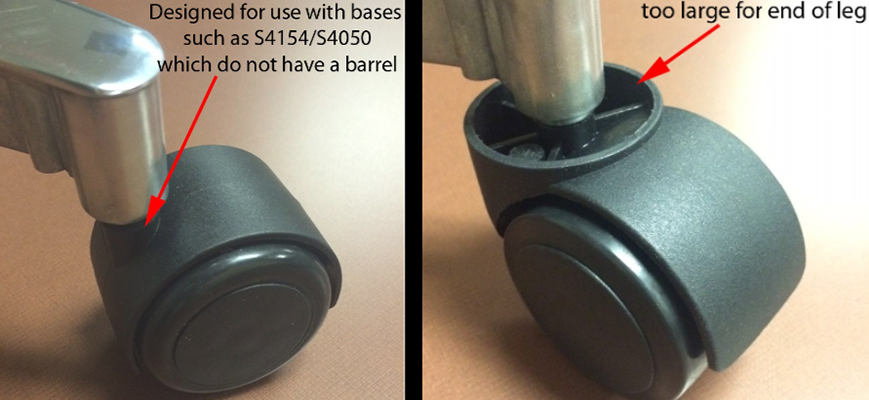Categories
Categories
- Home
- Help & Instructions
- Choose the Correct Parts
- Measure Casters
Measure Casters
Quick‐Start Overview
Watch this brief video (~30 seconds) to see exactly how to measure a caster correctly. It will guide you through stem and wheel measurements to ensure you select a perfect fit.
Note: All of our 7/16 x 7/8" stem casters work with all of our bases.
Determining Stem Size
To replace your chair casters, begin by measuring the stem—the part that inserts into the chair base. We carry several standard stem dimensions, as well as threaded varieties (see below).
- Popular stem sizes:
- 7/16″ × 7/8″ — common for chairs with plastic or metal bases
- 5/16″ × 1½″ — typical for chairs or furniture with wooden legs
Be sure to measure both the diameter and the length to match our offerings precisely.

Selecting Wheel Diameter
Next, measure the wheel itself. Take this measurement across the center (from one outer edge straight across to the opposite side) to find the diameter. This ensures compatibility and proper clearance.

Stem Type: Threaded vs. Smooth
If your caster stem is threaded, you’ll need to pay attention to these details:
- Diameter — e.g. ¼″ or 5⁄16″
- Thread length — Measure just the threaded portion
- Threads per inch (TPI) — Count how many threads are in a given length (for example, if a ½″ thread has 10 threads, then a 1″ thread would have ~20 threads, etc.)
We list stem dimensions in the format diameter‑TPI, such as “¼‑20.”
Note: You can usually replace a longer stem with a slightly shorter stem. If you have a shorter stem and want to use a longer, stick a small object up into the hole to measure the full depth - usually there's extra space beyond the existing stem, but you'll want to confirm.
FAQ:
Hard or Soft Wheels?:
This is an easy one - Hard floors need soft wheels, soft floors need hard wheels:
- Hard‐floor surfaces (hardwood, stone, tile, laminate, brick, linoleum): you’ll want soft wheels to protect against scuffs and marring.
- Soft floor surfaces (carpet, carpet tiles): choose hard wheels so movement is smooth and efficient.
What about that plastic neck thingy?
You may notice a plastic or metal collar at the top of some casters (above the stem) – this is called a barrel. It’s largely aesthetic, but also affects how the caster fits over the base leg.
- If the base-leg socket has an opening of 1.5″ or wider, a barreled caster will work.
- If you already have a barrel and like its look, feel free to choose one that includes it.
- If unsure, or if the existing setup doesn’t use one, it’s safe to omit the barrel.

The tread of my soft casters is crumbling - why?
Soft treads can degrade over time due to:
- Aging materials
- Exposure to UV light
- Harsh cleaning agents
If you notice crumbling, cracking, or separation, it’s generally time for a replacement to maintain safety and functionality.
In Summary
Once you’ve measured the following, you'll be ready to pick the right caster:
- Stem type, diameter, and length (or threaded details: TPI, etc.)
- Wheel diameter
- Whether a barrel is present, and whether you want one
- The type of wheel suitable for your flooring (hard vs. soft)
From there, it’s all about style and finish—choose the color and finish that best complements your chair and workspace.
 Loading... Please wait...
Loading... Please wait... 



